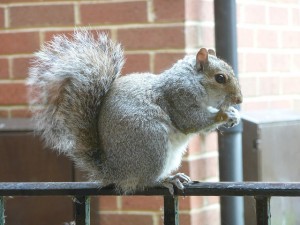Squirrels Description and Habitats

There are three types of squirrels most commonly found to become major nuisances in our service area; the Gray Squirrel, the Northern and Southern Flying Squirrels.
The gray squirrel is 18” to 20” long with the tail being half of that length weighing 1 to 1.5 lbs. They are grey above and white below and in the summer their head, legs and sides become washed with tawny brown. Their eye ring is puffy and their tail is long and bushy. The gray squirrel typically breeds from mid December through January have young in February and March. Gray squirrels typically have 2 to 4 young and may have a second litter in June or July.
The southern flying squirrel is 9” to 10” long including a 3.5” tail, weighing 1.5 to 2.5 ounces. The northern flying squirrel is slightly larger being 10” to 11” long including a 4.5” tail, weighing 3 to 4 ounces. They both have dense soft fur that is grayish brown above and a creamy white underneath. The eyes of a flying squirrel are exceptionally large in relation to its body size. At a glance the flying squirrel looks like it is ‘flying’, but in reality it glides from branch to branch. The most noticeable feature is the loose fold of skin, which extends from the wrists of the forearm to the ankles of the hind legs. This fold of skin is stretched when the legs are extended to form a wing-like surface that allows the flying squirrel to glide from tree to tree. The tail is furred and flattened. The southern flying squirrel typically breeds in early spring having young in May or June. The northern flying squirrel breeds in the late winter typically having young in April or May. They both will typically have 2 to 7 young.
All three types of squirrels maintain a similar diet; all through winter, they eat fruits and nuts (especially acorns, hickory nuts, and walnuts) and birdseed, if available. In early spring, they switch to tree buds, then in summer, to fruits, berries, and succulent plants. They will also eat insects; bird eggs; mushrooms; corn; garden, orchard, and field crops; and when very hungry, will chew tree bark and lick the sap.
Flying Squirrels are more likely to eat bird eggs, nestlings, insects, and carrion.
Squirrels Damage and the Health Hazards
One of the most common animal removal services we provide is to remove squirrels from an attic. During certain times of the year squirrels will enter homes and attics through existing holes or they will chew their way through weakened areas of roofs, vents and soffits to gain access to a warm safe attic. Once inside, squirrels can cause significant damage. Wildlife Busters Animal Damage Repair and Decontamination Services can assist in permanently resolving your squirrel issue.
Some of the most common forms of squirrel damage associated with squirrel infestations are:
- Damaged and shredded insulation.
- Feces and urine deposits.
- Stains in ceilings from squirrel urine.
- Strong odor from urine-soaked insulation.
The most serious danger associated with having squirrels in your attic is a fire hazard. Squirrels are destructive by nature and like all rodents they chew on electrical wiring. By chewing on wires they strip the plastic coating, which exposes the bare copper wire and creates a very dangerous situation.
This can all be avoided by utilizing Wildlife Busters animal trapping and removal services whereby we remove the squirrels from your attic and provide a warranty and prevention plan to ensure that your house is permanently squirrel-proofed.
Squirrel Removal and Control Services
Wildlife Busters Technicians are highly trained in locating all access points of entry for nuisance wildlife removal. Our years of hands on experience have taught us well. Our squirrel removal process includes the following steps:
- Thorough site inspection to locate squirrel access points
- Installation of one way doors where necessary as well as set traps for capture (if need be)
- Seal all access points
- Make habitat modification suggestions to property owner
Offer a long term warranty and prevention plan.
Picture by Simon Willison

 Receive FREE wildlife Tips!
Receive FREE wildlife Tips!
